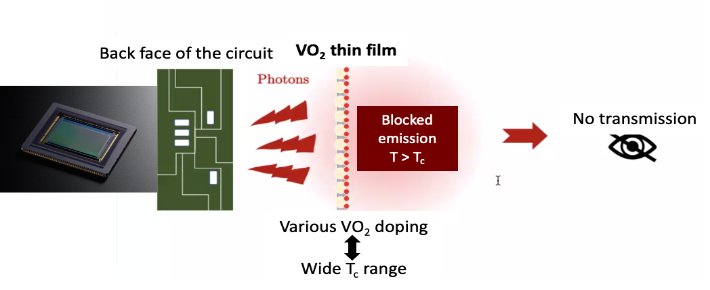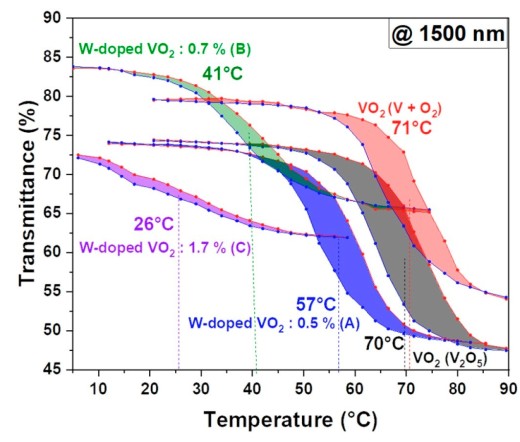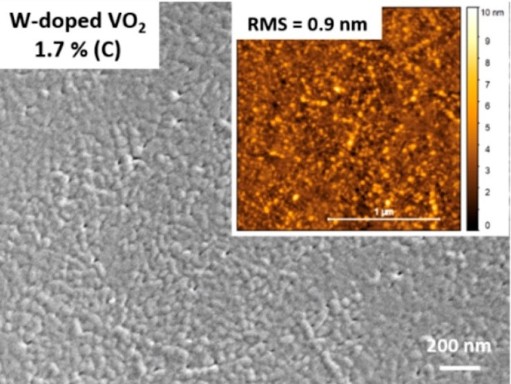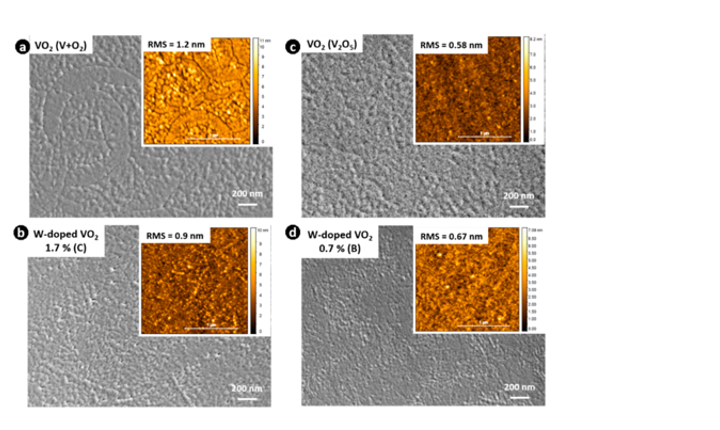Article: Towards Room Temperature Phase Transition of W-Doped VO2 Thin Films Deposited by Pulsed Laser Deposition: Thermochromic, Surface, and Structural Analysis
Materials is an open access journal that publishes papers advancing the understanding of the relationship between the structure, properties, and functions of various materials. Last January, an article by members of our Laser Matter Interaction team was selected for the Editor’s Choice section.
Electronic components such as integrated circuits (Figure 1) and optical components such as switch and filters require a higher degree of protection. This can be done through a thermally activated control, at various temperatures, of received or emitted radiations.
In integrated circuits, IR radiations are used for “hearing” passive attacks and active attacks by fault injections. In optical filters, switches and fibers, the reflection and transmission properties require a reversible dependence with temperature, at specific wavelengths.
The metal / insulating transition of vanadium oxide (VO2), associated to a significant change of emissivity and refraction index, was explored in the perspective of such applications.
The publication is part of the PROTECT project’s scientific production, supported by the LABEX MANUTECH-SISE. Three of our research teams were involved in this transversal project: Laser Matter Interaction, Functional Materials & Surfaces, and SESAM, combining people’s skills in design, film synthesis and optical characterizations.
This publication targeted the doping of VO2 thin films to reach both lower and more dispersed metal/insulator transition temperatures, in order to make attacks more random in integrated circuits. Tungsten-doped VO2 layers were synthetized by pulsed laser deposition. Their spectral behavior, both in reflection and transmission, were quantified versus temperature. Depending on the doping concentration and nanostructure of the synthetized film, the obtained metal/insulator transition temperatures extend over a wide range of temperatures: 26, 41, 57 and 71°C (Figure 2). The proof details the understanding of such dependence, on the basis of investigations of the films by complementary analytical probes: Angular Resolved XPS, Raman, SEM, AFM (Figure 3). Such a modulation could help to randomize the behavior of protective films in integrated circuits, or control the switch of optical components.
Abstract
Vanadium dioxide (VO2) with an insulator-to-metal (IMT) transition (~68 °C) is considered a very attractive thermochromic material for smart window applications. Indeed, tailoring and understanding the thermochromic and surface properties at lower temperatures can enable room-temperature applications. The effect of W doping on the thermochromic, surface, and nanostructure properties of VO2 thin film was investigated in the present proof. W-doped VO2 thin films with different W contents were deposited by pulsed laser deposition (PLD) using V/W (+O2) and V2O5/W multilayers. Rapid thermal annealing at 400–450 °C under oxygen flow was performed to crystallize the as-deposited films. The thermochromic, surface chemistry, structural, and morphological properties of the thin films obtained were investigated. The results showed that the V5+ was more surface sensitive and W distribution was homogeneous in all samples. Moreover, the V2O5 acted as a W diffusion barrier during the annealing stage, whereas the V+O2 environment favored W surface diffusion. The phase transition temperature gradually decreased with increasing W content with a high efficiency of −26 °C per at. % W. For the highest doping concentration of 1.7 at. %, VO2 showed room-temperature transition (26 °C) with high luminous transmittance (62%), indicating great potential for optical applications.
Read the full article here.

Figure 1: Protection of electronic circuits from passive attacks localized in the back face, by thermochromic VO2 thin films.

Figure 2: Hysteresis loops derived from the temperature-dependent transmittance of the undoped and W-doped (A, B, and C) VO2 thin films at a wavelength of 1500 nm.

Figure 3: SEM and AFM images of the W-doped VO2 thin films exhibiting a metal/insulator temperature near room temperature (26°C).

